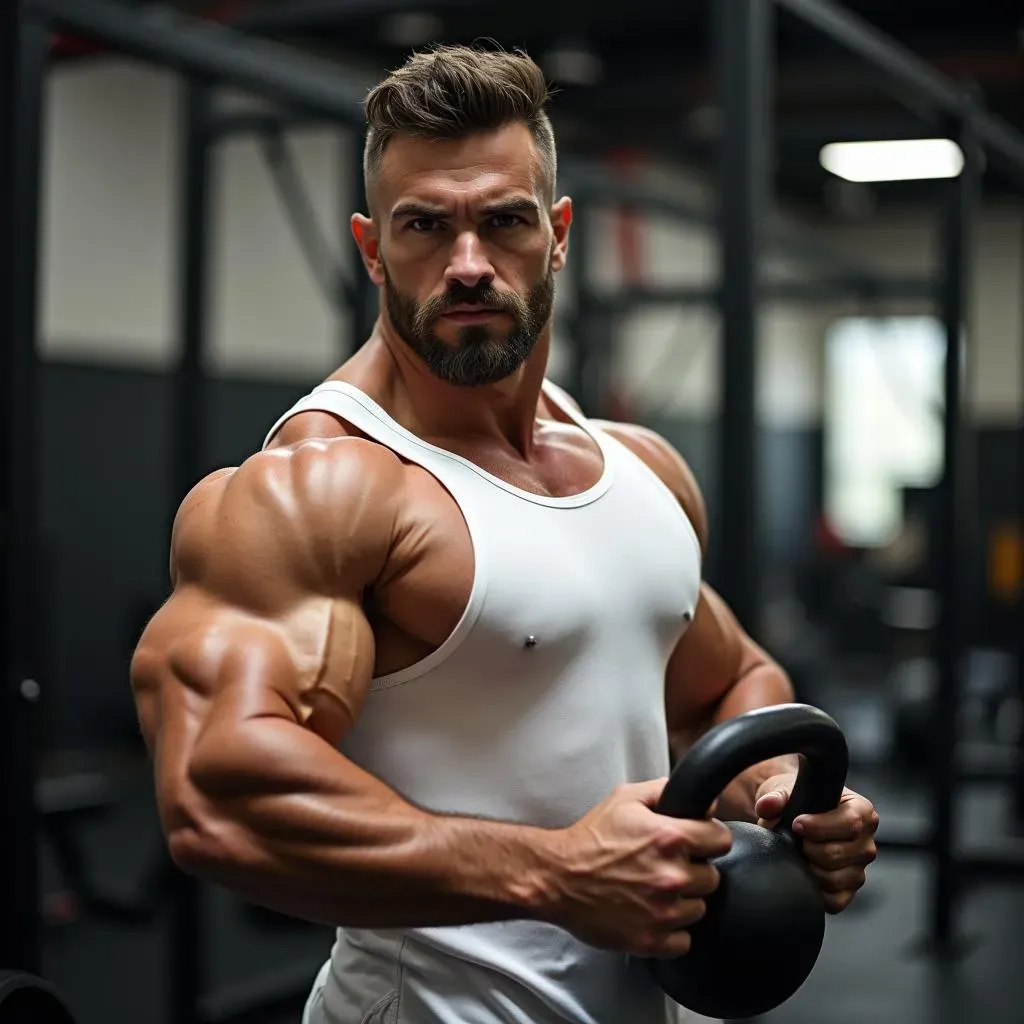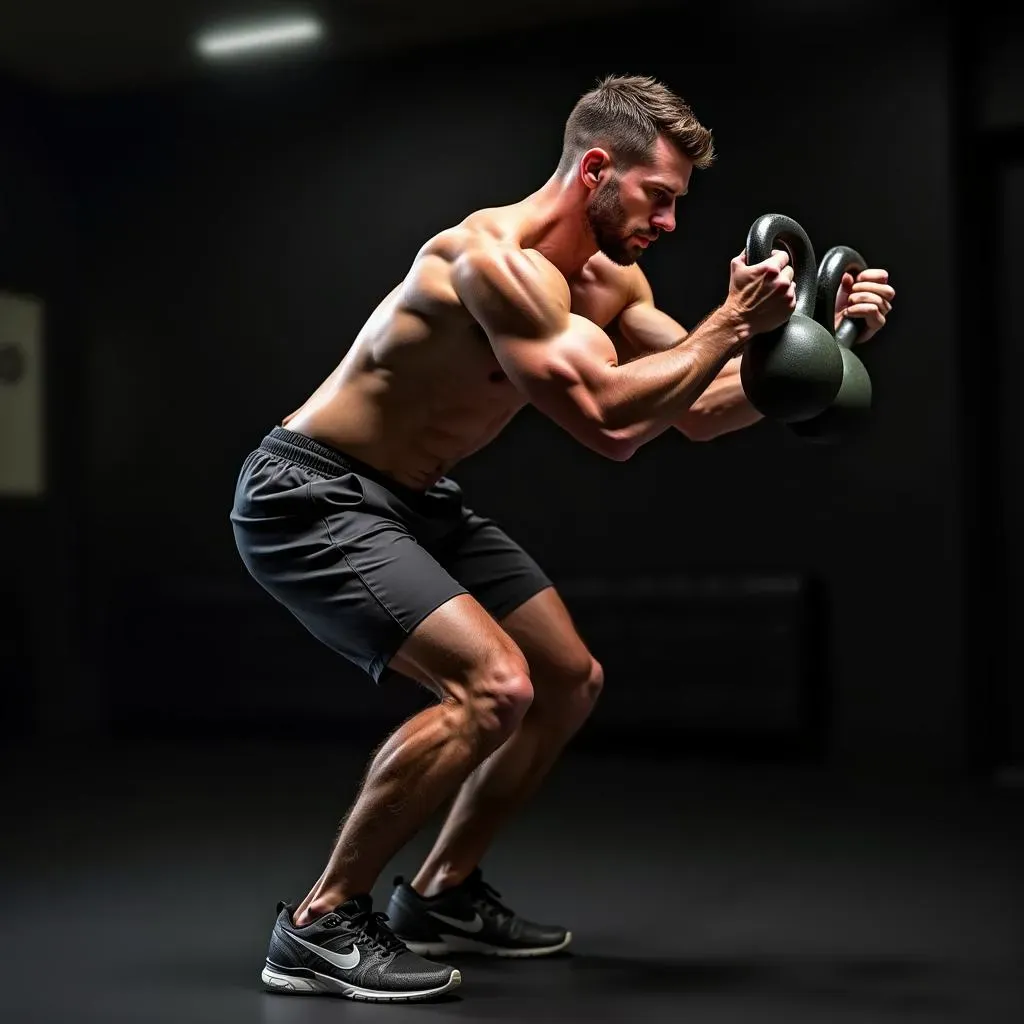Table of Contents
Ready to transform your arms and shoulders with a single piece of equipment? Kettlebell arm and shoulder workouts are your answer! Forget endless bicep curls and shoulder presses – kettlebells offer a dynamic, full-body approach to building strength and definition. We're diving deep into the world of kettlebell training, showing you why it's more than just a trend. This isn't just about lifting weight; it's about functional fitness that translates to real-world strength and a physique that turns heads.
Why Kettlebell Arm and Shoulder Workouts Are a Game Changer

Why Kettlebell Arm and Shoulder Workouts Are a Game Changer
Efficiency and Effectiveness Unleashed
Let's be real, who has hours to spend in the gym? Kettlebell workouts are a total game-changer because they're incredibly efficient. You're not just isolating muscles; you're engaging your entire body with every swing, press, and row. This means you're burning more calories, building more strength, and improving your cardiovascular fitness all at the same time. Forget those endless bicep curls – a kettlebell workout hits your arms, shoulders, core, and legs, giving you a full-body blast in a fraction of the time.
Think about it: a single kettlebell can replace a whole rack of dumbbells. It's perfect for home workouts, travel, or even a quick session in the park. Plus, the dynamic movements involved in kettlebell training improve your coordination, balance, and overall athleticism. It's not just about looking good; it's about feeling good and moving with power and grace.
Benefit | Why It Matters |
|---|---|
Full-Body Engagement | More calories burned, greater strength gains |
Time Efficiency | Workout smarter, not longer |
Improved Functionality | Better coordination, balance, and athleticism |
Beyond Isolation: Functional Strength for Real Life
The beauty of kettlebell training lies in its focus on functional strength. Unlike traditional weightlifting, which often isolates individual muscles, kettlebell exercises mimic real-life movements. Think about lifting a heavy grocery bag, carrying a child, or even just reaching for something on a high shelf. These are all compound movements that require multiple muscle groups working together. Kettlebell workouts train your body to move as a unit, making you stronger and more resilient in everyday activities.
Moreover, kettlebell training challenges your stability and core strength in ways that isolation exercises simply can't. The offset load of the kettlebell forces your body to constantly adjust and stabilize, strengthening your core and improving your posture. This not only enhances your athletic performance but also reduces your risk of injury. It's a win-win situation!
Essential Kettlebell Exercises for Arms and Shoulders

Essential Kettlebell Exercises for Arms and Shoulders
The Power Five: Must-Know Kettlebell Moves
Alright, let's get down to the nitty-gritty. If you're serious about building arm and shoulder strength with kettlebells, there are five essential exercises you absolutely need to master. These aren't just random movements; they're the foundation upon which you'll build a powerful and sculpted upper body. We're talking about exercises that target multiple muscle groups, improve your stability, and challenge your cardiovascular system all at once. Forget those endless isolation exercises – these moves are where the real magic happens.
Each of these exercises offers unique benefits, from building raw strength to improving mobility and coordination. We will start with kettlebell swings, overhead press, renegade rows, Turkish get-ups, and finish with clean and jerks. Master these, and you'll have a solid base for more advanced kettlebell training. Plus, you'll feel like a total badass wielding those cannonballs with handles!
- Kettlebell Swings: The king of kettlebell exercises, great for overall power and conditioning.
- Overhead Press: Builds shoulder strength and stability like nothing else.
- Renegade Rows: A challenging combination of plank and row, targeting your back, core, and arms.
- Turkish Get-Ups: A full-body movement that improves mobility, stability, and coordination.
- Clean and Jerks: A powerful combination move that builds explosive strength and power.
Breaking Down the Essentials: Form and Function
Now, let's dive deeper into each of these essential kettlebell exercises. It's not enough to just know the names – you need to understand the proper form and function of each movement to maximize its benefits and avoid injury. We're talking about engaging the right muscles, maintaining proper posture, and controlling the kettlebell throughout the entire range of motion. Trust me, sloppy form will not only limit your results but also set you up for a world of pain.
For each exercise, we'll break down the key points of proper form, the primary muscles targeted, and some common mistakes to avoid. We'll also provide modifications for different fitness levels, so you can start where you are and gradually progress as you get stronger. Remember, it's always better to start with lighter weight and perfect your form than to go too heavy and risk getting hurt.
Exercise | Key Form Points | Muscles Targeted | Common Mistakes |
|---|---|---|---|
Kettlebell Swing | Hinge at the hips, keep your back straight, drive with your glutes | Glutes, hamstrings, core, shoulders | Rounding the back, squatting too low, using your arms too much |
Overhead Press | Engage your core, keep your wrist straight, press straight up | Shoulders, triceps, core | Leaning back, using momentum, not locking out the elbow |
Renegade Row | Maintain a plank position, keep your core tight, row one arm at a time | Back, core, shoulders, arms | Rotating the hips, sagging the back, using too much weight |
Crafting Your Kettlebell Arm and Shoulder Workout Routine

Crafting Your Kettlebell Arm and Shoulder Workout Routine
Designing Your Perfect Kettlebell Circuit
so you've got the essential exercises down. Now, how do you weave them into a killer workout routine? That's where the fun begins! Crafting Your Kettlebell Arm and Shoulder Workout Routine isn't just about throwing exercises together; it's about creating a strategic plan that maximizes your results and keeps you motivated. Think of it like building a house – you need a solid foundation, a clear blueprint, and the right tools for the job. Your workout routine is your blueprint for building a stronger, more sculpted upper body.
First, consider your fitness level and goals. Are you a complete beginner, or are you already comfortable with kettlebell training? What are you hoping to achieve – more strength, more muscle definition, or improved endurance? Once you have a clear understanding of where you're starting and where you want to go, you can start to design a routine that's tailored to your specific needs.
- Beginner: Focus on mastering the basic exercises with proper form.
- Intermediate: Increase the weight or reps, and add more challenging variations.
- Advanced: Incorporate complex combinations and explosive movements.
Sets, Reps, and Rest: The Key to Progression
Once you've chosen your exercises, it's time to figure out how many sets and reps you should be doing, and how much rest you should be taking between sets. This is where things can get a little tricky, but don't worry – I'm here to break it down for you. The general rule of thumb is that higher reps with lighter weight are better for building endurance, while lower reps with heavier weight are better for building strength. But of course, there's more to it than that.
For building arm and shoulder strength, I recommend aiming for 3-4 sets of 8-12 reps per exercise. This rep range is ideal for stimulating muscle growth and increasing strength. As you get stronger, you can gradually increase the weight or resistance to continue challenging your muscles. Rest periods should be long enough to allow you to recover, but not so long that your muscles cool down completely. I typically recommend 60-90 seconds of rest between sets.
Goal | Sets | Reps | Rest |
|---|---|---|---|
Strength | 3-4 | 8-12 | 60-90 seconds |
Endurance | 2-3 | 15-20 | 30-45 seconds |
Advanced Kettlebell Techniques for Shoulder and Arm Strength

Advanced Kettlebell Techniques for Shoulder and Arm Strength
Unlocking Power with Kettlebell Flows
so you've nailed the basics. Now it's time to crank things up a notch with kettlebell flows! These aren't your grandma's arm exercises. We're talking about stringing together multiple movements into a seamless, continuous sequence. This not only challenges your strength and endurance but also improves your coordination, mobility, and mental focus. Think of it like a dance with a cannonball – graceful, powerful, and seriously effective.
Kettlebell flows are all about momentum and efficiency. You're using the force of one movement to transition into the next, creating a dynamic and engaging workout. This also means you're working more muscle groups at once, burning more calories, and getting a more comprehensive workout in less time. Plus, they look seriously impressive when you nail them!
- Double Kettlebell Flows: Twice the weight, twice the challenge.
- Around the Body Flows: Improve shoulder mobility and core stability.
- Complex Combinations: String together presses, rows, and swings for a full-body blast.
Isometric Holds for Maximum Muscle Engagement
Want to take your kettlebell training to the next level? Try incorporating isometric holds into your routine. Isometric exercises involve holding a muscle contraction in a static position, without any movement. This might sound easy, but trust me, it's anything but! Isometric holds are a fantastic way to increase muscle strength, improve stability, and enhance your mind-muscle connection.
For example, try holding a kettlebell in the overhead press position for 30-60 seconds. Or, hold a kettlebell in the bottom position of a renegade row. The key is to maintain perfect form and engage your muscles as hard as you can. You'll feel the burn in no time! Isometric holds are also a great way to improve your stability and control, which is essential for preventing injuries.
Exercise | Hold Position | Benefits |
|---|---|---|
Overhead Press | Kettlebell locked out overhead | Shoulder strength, stability, core engagement |
Renegade Row | Kettlebell in the bottom row position | Back strength, core stability, arm endurance |
Explosive Movements: Power Up Your Performance
Ready to unleash your inner beast? Explosive kettlebell movements are all about generating maximum power in a short amount of time. These exercises are fantastic for improving your athletic performance, increasing your strength, and building a more sculpted physique. We're talking about movements like kettlebell snatches, cleans, and jerks – exercises that require a combination of strength, speed, and coordination.
Explosive movements not only challenge your muscles but also improve your nervous system's ability to recruit muscle fibers. This means you'll be able to generate more force with every movement, whether you're lifting weights, playing sports, or just going about your daily life. Just remember to start with lighter weight and focus on mastering the proper technique before you start adding more weight. Safety first, always!
Avoiding Injury and Maximizing Results in Your Kettlebell Arm and Shoulder Workouts

Avoiding Injury and Maximizing Results in Your Kettlebell Arm and Shoulder Workouts
Listen to Your Body: The Golden Rule
Alright, let's talk about the most crucial aspect of any workout program: listening to your body. This isn't just some fluffy advice your yoga instructor throws around; it's the golden rule of avoiding injury and maximizing results. You're not a machine; you're a complex, biological system with its own unique set of needs and limitations. Pushing yourself too hard, ignoring pain signals, or neglecting recovery can quickly lead to setbacks and even serious injuries. Trust me, I've been there, and it's not pretty.
Learn to differentiate between discomfort and pain. Discomfort is that burning sensation you feel when you're pushing your muscles to their limits. Pain, on the other hand, is a sharp, stabbing, or aching sensation that indicates something is wrong. If you feel pain, stop immediately and assess the situation. Don't try to "push through it" – that's a recipe for disaster. Rest, ice, compression, and elevation (RICE) are your best friends in these situations. And if the pain persists, don't hesitate to seek professional medical advice.
Progressive Overload: The Key to Long-Term Gains
So, you're listening to your body, avoiding pain, and consistently showing up for your workouts. That's fantastic! But if you want to continue seeing results, you need to implement the principle of progressive overload. This simply means gradually increasing the demands on your muscles over time. If you keep doing the same workouts with the same weight, your body will adapt, and you'll eventually plateau. Progressive overload is the key to breaking through plateaus and achieving long-term gains.
There are several ways to implement progressive overload in your kettlebell training. You can increase the weight, increase the reps, increase the sets, decrease the rest time, or add more challenging variations of the exercises. The key is to make small, incremental changes that challenge your muscles without overwhelming them. Track your progress and make adjustments as needed. Remember, consistency is key. Keep pushing yourself, but always listen to your body and avoid overtraining.
Method | Description | Example |
|---|---|---|
Increase Weight | Gradually add more weight to your kettlebell exercises. | Move from a 16kg kettlebell to a 20kg kettlebell for swings. |
Increase Reps | Increase the number of repetitions you perform per set. | Go from 8 reps of overhead press to 10 reps. |
Increase Sets | Add more sets to your workout routine. | Perform 4 sets of renegade rows instead of 3. |
Warm-Up and Cool-Down: Non-Negotiable Rituals
Never, ever skip your warm-up and cool-down. I know, I know, they can feel like a waste of time when you're itching to get to the "real" workout. But trust me, these are non-negotiable rituals that will significantly reduce your risk of injury and improve your performance. A proper warm-up prepares your muscles and joints for the demands of the workout, while a cool-down helps your body recover and prevents muscle soreness.
Your warm-up should include dynamic stretching and light cardio. Dynamic stretching involves moving your joints through a full range of motion, such as arm circles, leg swings, and torso twists. Light cardio, such as jogging or jumping jacks, increases blood flow to your muscles and raises your body temperature. Your cool-down should include static stretching, holding each stretch for 30-60 seconds. Focus on stretching the muscles you worked during the workout, such as your shoulders, arms, back, and core.
- Warm-up: Dynamic stretching, light cardio (5-10 minutes)
- Cool-down: Static stretching (5-10 minutes)
Conclusion
Incorporating kettlebell arm and shoulder workouts into your fitness regime can be a total game-changer. From building functional strength and sculpting lean muscle to torching calories and boosting overall fitness, the benefits are undeniable. Remember, consistency, proper form, and gradual progression are key to achieving your goals and avoiding injury. So, keep swinging, pressing, and snatching your way to a stronger, more defined upper body. Your journey to sculpted arms and shoulders starts now – pick up that kettlebell and make it happen!